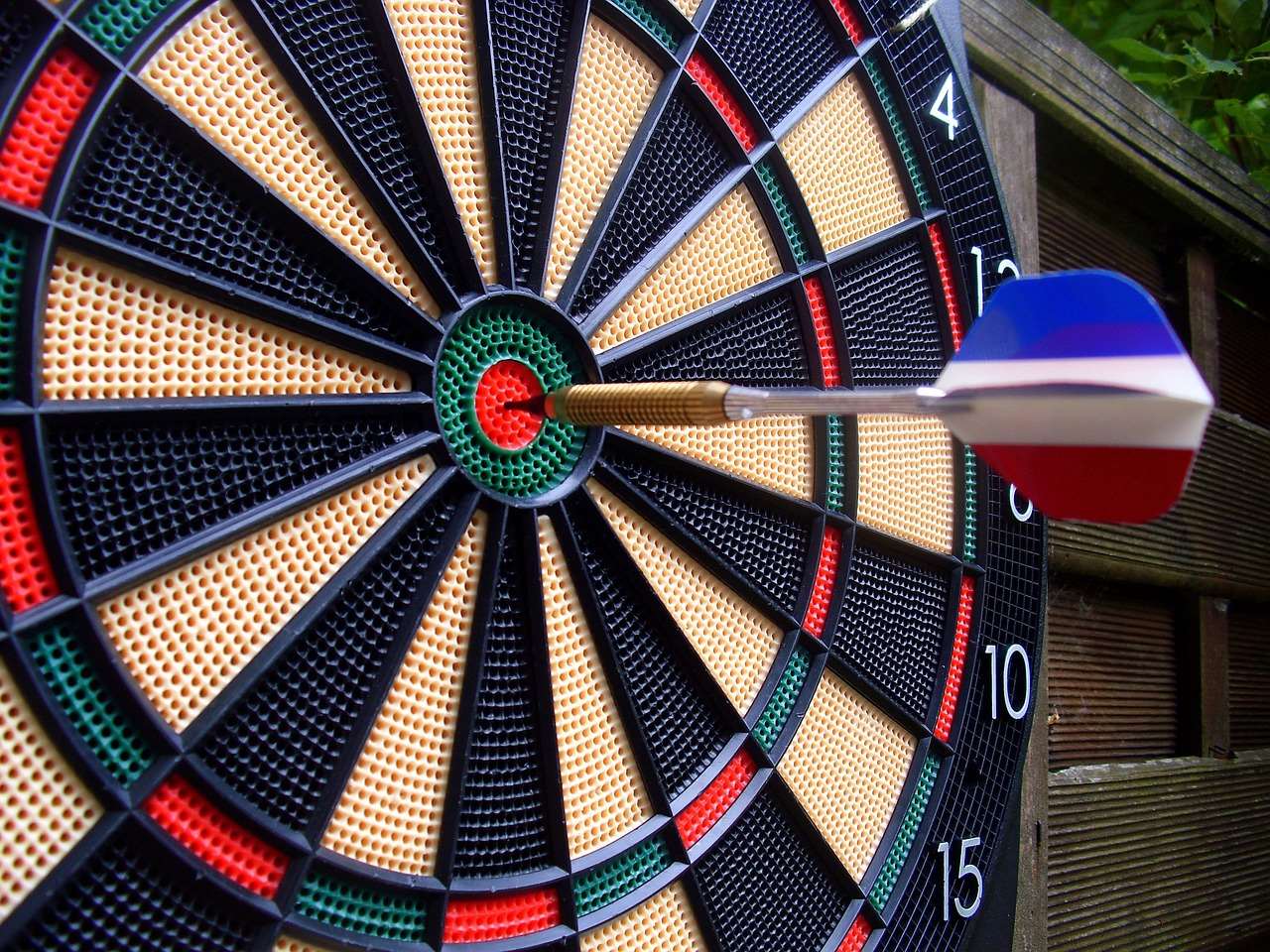Want to quickly understand the rules of Cricket darts? The goal is to close out numbers by hitting them three times before your opponent does, while also aiming to be the first to close out the bullseye. This comprehensive guide will provide a Cricket darts quick rules summary, covering everything from setup to scoring, and even strategic tips to help you win.
⚠️ Still Using Pen & Paper (or a Chalkboard)?! ⚠️
Step into the future! The Dart Counter App handles all the scoring, suggests checkouts, and tracks your stats automatically. It's easier than you think!
Try the Smart Dart Counter App FREE!Ready for an upgrade? Click above!
Understanding the Basics: A Cricket Darts Quick Rules Summary
Cricket is a strategic darts game enjoyed by players of all skill levels. Unlike some darts games focused on accumulating points, Cricket is about claiming and closing numbers. A solid Cricket darts quick rules summary starts with understanding the numbers in play and the objective.
Numbers in Play
The standard Cricket game uses the following numbers: 20, 19, 18, 17, 16, 15, and the bullseye (either single or double bull). These are the numbers that players will be aiming to hit and close out.
The Objective of the Game
The primary goal is to be the first player to “close” all seven numbers (20, 19, 18, 17, 16, 15, and the bullseye) by hitting each number three times, and to have a score equal to or higher than your opponent. If you close all the numbers first but are behind in score, you still need to catch up in points. This dynamic adds a strategic layer to the game.

Setting Up Your Cricket Darts Game
Proper setup is essential for a fair and enjoyable game. Here’s how to get everything ready for your next match.
Dartboard Setup
Ensure your dartboard is hung correctly. The center of the bullseye should be 5 feet 8 inches (1.73 meters) from the floor. The oche (throwing line) should be 7 feet 9 1/4 inches (2.37 meters) from the face of the dartboard.
Determining the First Player
Players can toss a dart at the bullseye (closest to the bull wins) or flip a coin to decide who goes first. The winner of this initial toss has the advantage of going first.
Gameplay: Claiming and Closing Numbers
The core of Cricket lies in claiming numbers and preventing your opponent from scoring on them. The first hit “opens” the number, and subsequent hits score points if the opponent hasn’t closed it yet.
Opening a Number
The first time you hit one of the target numbers (20, 19, 18, 17, 16, 15, or the bullseye), you “open” that number. This means you can now score points on it, assuming your opponent hasn’t closed it.
Scoring on Open Numbers
Once a number is open, each subsequent hit on that number before it’s closed earns you points. The score is determined by the segment hit. For example:
- Hitting the single 20 scores 20 points.
- Hitting the double 20 scores 40 points.
- Hitting the triple 20 scores 60 points.
Closing a Number
Hitting a number a total of three times “closes” it for you. This means your opponent can no longer score on that number, even if they’ve opened it. Closing a number requires strategy; sometimes, you may want to delay closing to maximize your scoring potential, or close it to shut out your opponent.
The Role of the Bullseye
The bullseye counts as one of the numbers to be closed. The outer bull (single bull) counts as one hit, and the inner bull (double bull) counts as two hits. Therefore, hitting the double bull closes the bullseye in one throw if it’s already been hit once or opens and closes it in one throw if it is unopened.

Winning the Game: Strategy and Scoring
Winning Cricket involves not only closing numbers but also managing your score strategically.
Closing All Numbers First
If you are the first to close all seven numbers, you win the game, provided you also have a score equal to or greater than your opponent. If your score is lower, you must continue playing until you either surpass your opponent’s score or they close all the numbers and have a higher score than you.
The Importance of Score
It’s crucial to pay attention to your score relative to your opponent. Don’t just focus on closing numbers; you need to accumulate points as well. This might involve scoring heavily on open numbers before closing them, or targeting numbers your opponent hasn’t opened yet.
Defensive Strategies
Sometimes, the best strategy is defensive. If your opponent is scoring heavily on a particular number, you might prioritize closing it to prevent them from gaining further points. This might involve aiming for triples or doubles to close the number quickly.
Common Scenarios and Rule Clarifications
Certain situations can arise during a Cricket game that require clarification of the rules.
Opponent Unable to Score
If you have closed all the numbers, you can continue to score on any open numbers your opponent has. This can help you increase your lead and secure your victory.
Busting (Going Over)
There is no “busting” rule in Cricket like in ’01 games. You can continue to score on open numbers regardless of your score. The only way to lose is to have a lower score than your opponent while also closing all the numbers first. This leads to some interesting strategy when Adjusting dart game rules.

Tips for Improving Your Cricket Darts Game
Here are some practical tips to help you elevate your Cricket darts skills:
- Practice your accuracy: Consistently hitting the target numbers is essential.
- Develop a throwing routine: A consistent routine helps with accuracy and reduces variability.
- Learn to aim for triples and doubles: This will allow you to close numbers more quickly and score more points.
- Study your opponent: Pay attention to their strengths and weaknesses and adjust your strategy accordingly. Understanding how to Scaling dart game difficulty is important.
- Stay calm and focused: Darts is a mental game, so maintaining composure is crucial.
Advanced Strategies in Cricket Darts
Beyond the basics, more advanced strategies can give you a competitive edge. These tactics require careful planning and execution.
Strategic Number Selection
Choosing which numbers to target first can significantly impact the game. Some players prefer to start with the higher numbers (20, 19) to maximize scoring potential, while others may focus on numbers their opponent struggles with. This all becomes a critical component of understanding Darts Variants Fun Games
Controlling the Board
Controlling the board means dictating the pace and flow of the game. This involves both scoring points and denying your opponent opportunities. A good way to Adapting darts games skills is to get to know all the aspects of the game.
Utilizing Doubles and Triples for Defense
Sometimes, the best move is to use doubles and triples defensively. For example, if your opponent is about to close a number and potentially take the lead, you might prioritize closing it yourself, even if it means sacrificing scoring opportunities on other numbers.

Cricket Darts: Beyond the Standard Game
While the standard version is popular, variations on Cricket offer unique challenges and twists.
Cut-Throat Cricket
In Cut-Throat Cricket, the scoring rules are reversed. Instead of earning points for hitting open numbers, you give your opponents those points. The goal is to have the lowest score when all numbers are closed. This variation encourages a more defensive and strategic approach.
Wild Card Cricket
Wild Card Cricket introduces random elements that can dramatically alter the game. For example, a designated “wild card” number might be worth double or triple points, or it might instantly close when hit. This variation adds an element of unpredictability and requires players to adapt quickly.
Team Cricket
Cricket can also be played in teams. Team Cricket introduces new strategic considerations, such as coordinating with your teammate to control the board and maximize scoring opportunities. This is a fun way of Darts for mixed ability groups.

Practice Drills for Cricket Darts Mastery
Consistent practice is key to improving your Cricket game. Here are a few drills to help you hone your skills.
Target Practice
Focus on hitting each of the target numbers (20, 19, 18, 17, 16, 15, and the bullseye) repeatedly. Start with the single segments and gradually progress to doubles and triples.
Closing Drill
Simulate closing numbers by hitting each number three times in a row. This will improve your accuracy and consistency under pressure.
Scoring Drill
Practice scoring on open numbers while simultaneously trying to close them. This will help you develop a more well-rounded game.
Conclusion: Mastering Cricket Darts
Cricket is a dynamic and engaging darts game that combines strategy, accuracy, and mental fortitude. This Cricket darts quick rules summary has provided you with the essential knowledge to understand and play the game. By understanding the rules, practicing regularly, and implementing strategic tactics, you can elevate your Cricket game and enjoy countless hours of competitive fun. Now, grab your darts, step up to the oche, and start playing! Check out other resources to improve your game and dominate the dartboard!
Hi, I’m Dieter, and I created Dartcounter (Dartcounterapp.com). My motivation wasn’t being a darts expert – quite the opposite! When I first started playing, I loved the game but found keeping accurate scores and tracking stats difficult and distracting.
I figured I couldn’t be the only one struggling with this. So, I decided to build a solution: an easy-to-use application that everyone, no matter their experience level, could use to manage scoring effortlessly.
My goal for Dartcounter was simple: let the app handle the numbers – the scoring, the averages, the stats, even checkout suggestions – so players could focus purely on their throw and enjoying the game. It began as a way to solve my own beginner’s problem, and I’m thrilled it has grown into a helpful tool for the wider darts community.